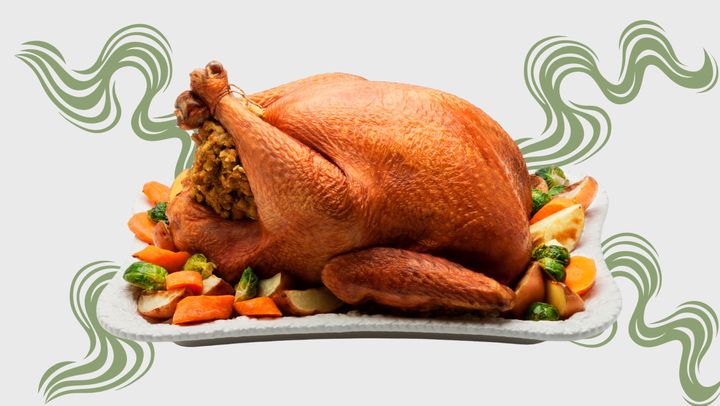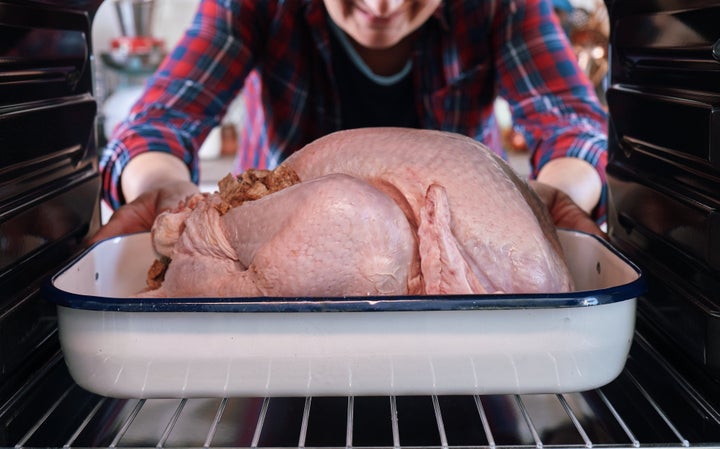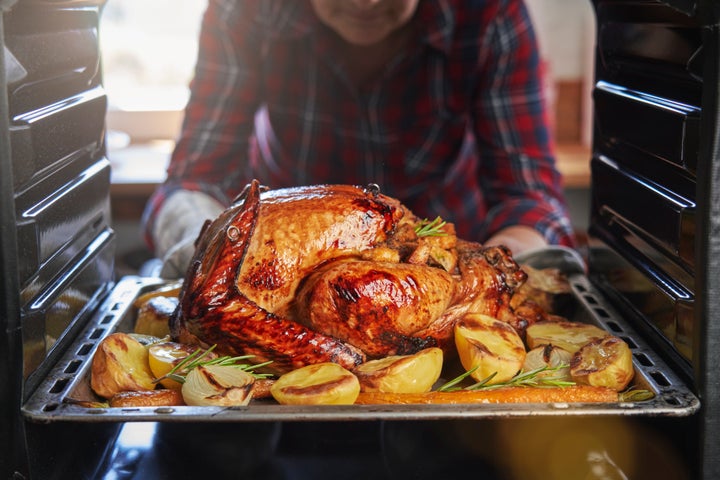
You’ve purchased a Thanksgiving turkey and the fixings to accompany it. You’re feeling anxious as you slowly cross all the items off your to-do lists as you get closer to the day of preparation and cooking. Food safety is likely far from your mind as you’re focused on having enough side dishes, drinks and desserts for everyone. But it shouldn’t be.
“When you’re preparing a holiday meal, usually for a larger group of people, you’re preparing more food and you’re a little bit more rushed,” said Keith Schneider, a food safety professor in the department of food science and human nutrition at the University of Florida. “You may be more prone to make mistakes.”
The last thing you want to do is put anyone at risk of getting a foodborne illness. According to Joshua Resnick, lead chef at theInstitute of Culinary Education who is fully certified in food protection by the New York City Department of Health and Mental Hygiene, “In the case of a large bird, you’re normally feeding a big crowd and don’t want to get a lot of people sick. You definitely want to keep safety in mind as much as flavor.”
HuffPost spoke with food safety experts on the biggest mistakes people make when preparing and cooking turkey and what to do instead.
Not Washing Your Hands
Washing your hands with hot water and soap should be the first thing you do before you begin any food preparation, especially when cooking a large meal. Experts say people sometimes forget this basic step when handling raw turkey.
“People don’t even realize that they’ll rub their noses, they’ll run their fingers through their hair or wipe the sweat from their brow as they’re preparing a meal for 20 people,” Schneider said. “And not realize what they’re doing.”
Be prepared to wash numerous times when preparing and cooking turkey. “Wash your hands at least 20 to 30 seconds each time you handle the turkey and it’s in a raw state,” advised Ray Campbell, a health and safety manager at Tulane University’s dining services program.

Thawing Your Turkey Anywhere But The Fridge
Proper thawing is key to even cooking and eliminating pathogens.
“You should never, ever thaw the turkey or other foods on the counter. Thaw your turkey in the refrigerator,” said Darin Detwiler, a professor of food policy and corporate social responsibility at Northeastern University and author of ”Food Safety: Past, Present, and Predictions.”
And according to Campbell, “Bacteria, germs and other harmful pathogens grow at an alarming rate when the turkey is thawed at room temperature.”
Defrosting a turkey requires preparation, space in your fridge and a minimum of 24 hours or longer, depending on the size of the bird. Check out our guide on how long it takes to thaw every size of turkey. “It’s amazing how many people try to thaw turkey really quickly,” Detwiler commented. Doing so puts you at risk for a foodborne illness.
There’s a rule of thumb to know just how long it will take to defrost the turkey. “You need 24 hours for every four to five pounds of a bird,” Campbell explained. “So if you got an 8-to-10-pound turkey, you need about 48 hours.” Don’t count the days, count by the hour to make sure it’s fully defrosted. “Some people take out the turkey on Thursday but they may have put it in on Wednesday at 6 o’clock in the evening and now it’s Thursday morning, at 8 o’clock,” he said. “That’s not 24 hours.”
Cooking Frozen Turkey
If you’re thinking, who cares if part of the turkey is frozen, it will cook in the oven, you’ll want to think again. A frozen turkey will cook unevenly, so you’ll have overcooked and undercooked meat.
“They put it in the oven without it thawing completely, leading to parts of the meat overcooking by the time everything reaches a safe temperature. Or they temp it improperly and end up serving undercooked meat,” Resnick said.
Allowing Your Thawing Turkey Juices To Drip Into Your Fridge
While thawing a turkey in the fridge, make sure you place it on top of a tray to catch any liquid and avoid cross-contamination.
“I recommend keeping the turkey in the original wrapping and putting it inside another container or on a two-inch pan or something of that nature,” Campbell explained. This will catch any liquids and prevent them from dripping and potentially spreading pathogens in the fridge.
“Put the turkey on top of a tray with a lip so that if there are any juices, they don’t drip down and get into things that are not cooked, like your salad ingredients,” Detwiler said.
Washing Your Turkey
Some people always wash their poultry before cooking, while some have never heard of the practice. Food safety experts warn that washing turkey is a fantastic way to spread a lot of bacteria throughout your kitchen. There are more risks washing your bird than if you were to not wash it.
Washing a turkey or chicken is not a “kill step,” an operative word in the food industry for preventing a foodborne pathogen. “If there are pathogens on the turkey, it just spreads around your kitchen,” Detwiler said. “Your entire sink area now is basically a contaminated danger zone.”
And it’s not only your sink you need to be concerned about. Campbell added, “Surfaces, such as sinks, countertops, dishes, dish towels and dish racks can become contaminated.”
If you or your family have always washed poultry, it can be easy to think it’s a necessary part of food preparation. Schneider explained that this is a common reason people continue to wash meat. “One of the things we run into is that most people tend to have a false sense of security because they’ve done something for so long, and no one’s gotten ill so it reinforces that behavior,” he said. “Washing is not going to make the bird safer.”
Schneider knows habits can be hard to break, so he recommends that if you still plan to wash your meat, don’t use high pressure to rinse the turkey and thoroughly clean your kitchen. “Make sure that you sanitize afterwards so that you don’t potentially cross-contaminate your cutting board, utensils and other things in the kitchen,” he said. He recommends using an antibacterial kitchen cleaner that kills 99.9% of bacteria.

Just Letting The Turkey Sit In The Oven
Ovens don’t have an equal temperature throughout. Rotating the turkey while it’s cooking will help it cook thoroughly. If you just place the pan in the oven and wait until it’s done, it’s likely that some parts of the turkey will cook faster than others.
“The best way to ensure that your bird cooks evenly and to a proper temperature would be to rotate the bird, as ovens have hot and cool zones, to ensure an even cooking,” Resnick said.
Not Using A Meat Thermometer
Cook meat frequently at home? A meat thermometer should be in your kitchen. Checking the temperature is the only way to know if the turkey is cooked thoroughly. Similar to chicken, you don’t want to eat slightly raw turkey. “Harmful pathogens can be present in undercooked turkey,” Campbell said. According to Science Direct, pathogens in raw turkey can include campylobacter, clostridium perfringens and salmonella.
“People should use a food-grade thermometer, not the so-called pop-up kind to ensure that an internal temperature of 165 degrees Fahrenheit has been met,” Campbell explained. When the bird has reached the minimum temperature it’s going to inactivate the microbes.
Wondering where to insert your meat thermometer? Measure the temperature in the thickest areas of the turkey for the most accurate results. “Always insert the thermometer into the thickest part of the turkey, usually the breast, or where the body of the bird joins the thigh or wing joint,” Campbell advised.
Resnick recommends taking multiple readings, too. “People will temp one part of the turkey and go off of one reading instead of checking in multiple spots and ensuring that everything is cooked through properly.”
We Need Your Support
Already contributed? Log in to hide these messages.
Stuffing The Turkey
If you always stuff your turkey, you’ve likely participated in debates about this contentious topic. Campbell knows this well as he prefaced his comments by saying, “Most of the older generation might not like this because it kind of goes against tradition: It’s safer to cook stuffing outside of the turkey instead of stuffing the turkey.”
To make sure potential pathogens haven’t survived, “the internal temperature of the stuffing needs to reach 165 degrees at its center,” Campbell said. The reason is rooted in science. “When you put a very spongy bread stuffing inside the bird, as it cooks the water evaporates and you get evaporative cooling, but the stuffing inside of the bird where a lot of the pathogens hideout will remain slightly cooler than the environment around it,” Schneider explained.
This is why food safety experts say stuffing should be cooked separately. “Cook stuffing in a casserole dish, regular baking pan or aluminum baking pan,” Campbell said.